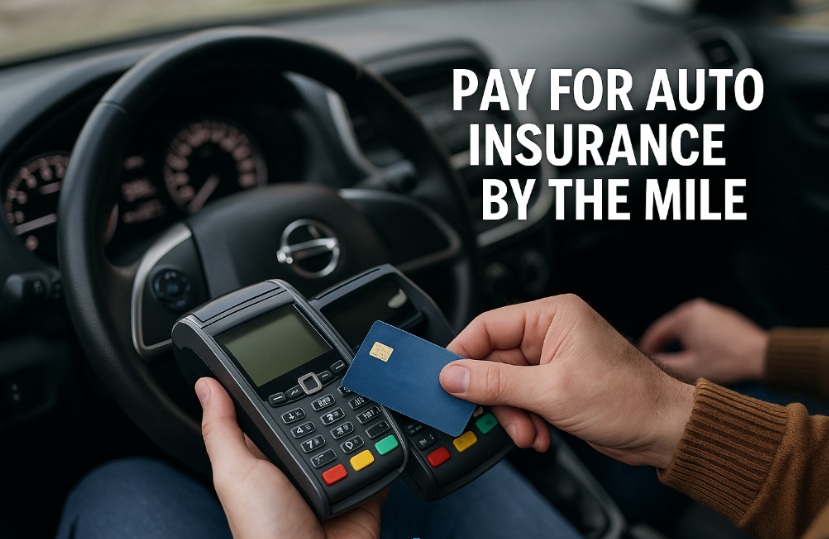Many people find paying for car insurance a big expense. Pay-per-mile auto insurance is becoming popular. This article will show how this type of insurance can save you money and give you more control.
Keep reading to learn more.
What Is Pay-Per-Mile Auto Insurance?
Pay-per-mile auto insurance is a type of car insurance plan where your premium is based on how many miles you drive. If you drive less, you pay less. This kind of insurance uses a device in your car or an app to track the distance you travel.
With pay-as-you-go car insurance plans, customers only pay for what they use, making it an excellent choice for saving money. In fact, many drivers looking for flexible coverage options like pay-as-you-go auto insurance are turning to this model for better control over their costs.
How Pay-Per-Mile Insurance Works
After learning what pay-per-mile auto insurance is, let’s look at how it operates. This type of insurance charges drivers based on how many miles they drive.
- Drivers first share their car’s odometer reading to set a starting point.
- A small device plugs into the car. It tracks miles driven.
- Each month, the driver pays a base rate plus a per-mile charge.
- The base rate is fixed. It does not change with the miles driven.
- The per-mile rate multiplied by the number of miles driven for that month’s cost.
- Insurance companies use an app or website for drivers to see their driving data.
- This system encourages people to drive less. They save money if they do.
- All usual coverages apply, like in traditional auto insurance policies.
- The bill comes monthly, with clear details on miles driven and total cost.
This setup helps drivers control their insurance costs by monitoring and adjusting their driving habits.
Reasons Drivers Are Switching to Pay-Per-Mile Insurance
More drivers are choosing pay-per-mile insurance for its cost savings, flexibility, transparency, and driving incentives. For more detailed insights into this growing trend, read the full blog.
Cost savings for low-mileage drivers
Drivers who don’t use their car much save money with pay-per-mile insurance. They only pay for the miles they drive. This makes auto insurance cheaper for them. If you drive less, maybe just on weekends or short trips around town, this type of plan can cut your costs.
Pay-per-mile plans track how many miles you drive. Then they charge a fee based on that amount. Less driving means lower bills each month. For people who work from home or live close to where they need to go, this can lead to huge savings over time.
Flexibility and control over premiums
Flexibility and control over premiums are major draws of pay-per-mile insurance for drivers. With this model, drivers have the power to adjust their premium based on their actual usage.
This means that low-mileage drivers who maintain safe driving habits can potentially save a significant amount on their car insurance, as they aren’t paying traditional flat rates that don’t reflect how much they drive.
The ability to monitor and manage premiums according to individual driving behaviors provides a sense of empowerment for policyholders, giving them more influence over their insurance costs.
Pay-per-mile insurance offers the advantage of tailoring premiums to match your actual driving habits, providing an unprecedented level of control and flexibility.
Transparency in billing
Transparency in billing is a crucial benefit of pay-per-mile auto insurance. This type of insurance lets drivers see exactly what they’re paying for, based on the number of miles driven.
With transparent billing, there are no surprises or hidden fees. Drivers can easily track their mileage and premiums, giving them confidence in their coverage.
By having a clear view of how much they’re being charged for insurance, drivers can better manage their budget and have peace of mind knowing they are only paying for what they use.
This transparency fosters trust between the insurance provider and the policyholder, creating a more honest and open relationship. It also aligns with the modern consumer’s desire for straightforward pricing and understandable services.
Incentives for driving less
Drivers who opt for pay-per-mile insurance receive incentives for driving less. This means lower premiums for those who don’t drive much. Paying only for the miles you actually drive can lead to significant cost savings, especially for individuals with low annual mileage.
In addition, this presents an opportunity to play a role in reducing carbon emissions and contributing positively to the environment by minimizing vehicle usage – something that’s increasingly important today.
Moreover, some pay-per-mile insurance providers offer rewards programs and discounts based on safe driving habits or reduced mileage, offering additional motivation to cut down on unnecessary trips.
This not only benefits individual drivers but also contributes to overall safety and reduced congestion on roadways, which is beneficial for everyone.
Who Benefits the Most from Pay-Per-Mile Insurance?
Low-mileage drivers benefit the most from pay-per-mile insurance. Typically, people who drive less than 10,000 miles a year can save significantly with this type of insurance. It is especially advantageous for individuals who regularly use public transportation or work from home, as they tend to have lower annual mileage.
It’s great for people who don’t use their cars much and want cheap car insurance in Georgia with a low down payment, particularly if they’re looking to minimize upfront costs while still getting reliable coverage.
It’s great for people who don’t use their cars much and want cheap car insurance in Georgia with a low down payment, especially when considering affordable plans from Loya Insurance.
Moreover, those who drive infrequently due to retirement or living in walkable neighborhoods can also reap substantial savings with pay-per-mile insurance.
Additionally, young drivers and seniors can also benefit from this model because they often drive fewer miles than the average adult. For instance, some young adults may not commute long distances to work or school due to remote working options or online learning platforms.
Conversely, seniors often have limited mobility needs and typically don’t use their vehicles as frequently as they did when they were in their prime driving years. Therefore, pay-per-mile insurance offers these demographics an opportunity to align their premiums more closely with their actual usage patterns.
Top Companies Offering Pay-Per-Mile Insurance
Shifting our focus to the industry leaders in pay-per-mile insurance, we examine companies that stand out by offering adjustable and economical insurance policies that correspond to the distance you travel.
| Company | Features | Availability |
| Metromile | Real-time tracking, easy claims, and low average rates | 8 states |
| Nationwide (SmartMiles) | Discounts for safe driving, variable rates based on mileage | Most states |
| Allstate (Milewise) | Pay-per-mile system with daily cap, good for high-mileage days | 14 states |
| Esurance (Pay Per Mile) | Manage policy via mobile app, straightforward billing | Limited availability |
| Liberty Mutual (ByMile) | Low base rate, mileage rate, easy tracking with the app | Select markets |
| Progressive (Snapshot) | Personalized rates based on driving behavior, not just mileage | Available in most states |
These firms have adjusted their offerings to accommodate the preferences of motorists who desire greater influence over their automobile insurance expenses. With a variety of options in different states, drivers can select a provider that aligns well with their driving patterns and financial plan.
Pros and Cons of Pay-Per-Mile Insurance
Evaluating the benefits and drawbacks of pay-per-mile insurance reveals both its appeal and limitations. Here’s a summary in table format:
| Pros | Cons |
| Cost savings for drivers who don’t drive much. | High-mileage drivers might pay more than with traditional plans. |
| Flexibility to control your premium based on miles driven. | Requires GPS tracking or similar technology, raising privacy concerns. |
| Transparent billing shows exactly what you’re paying for. | Not available in all states or from all insurance companies. |
| Incentives for driving less can reduce traffic and pollution. | May not cover all types of vehicles or driving needs. |
These perspectives crystallize the main points of consideration for anyone thinking about switching to pay-per-mile insurance.
Conclusion
More drivers are choosing pay-per-mile auto insurance due to its potential cost savings for low-mileage drivers. This insurance type also provides flexibility, transparent billing, and incentives for driving less.
It’s a favorable option for individuals who drive fewer miles than the average driver.
Additionally, a few leading companies offer pay-per-mile insurance, ensuring a range of options to meet specific requirements. Although there are advantages and disadvantages to weigh, pay-per-mile insurance appears to be increasingly popular as an attractive choice for numerous drivers in the present day.



